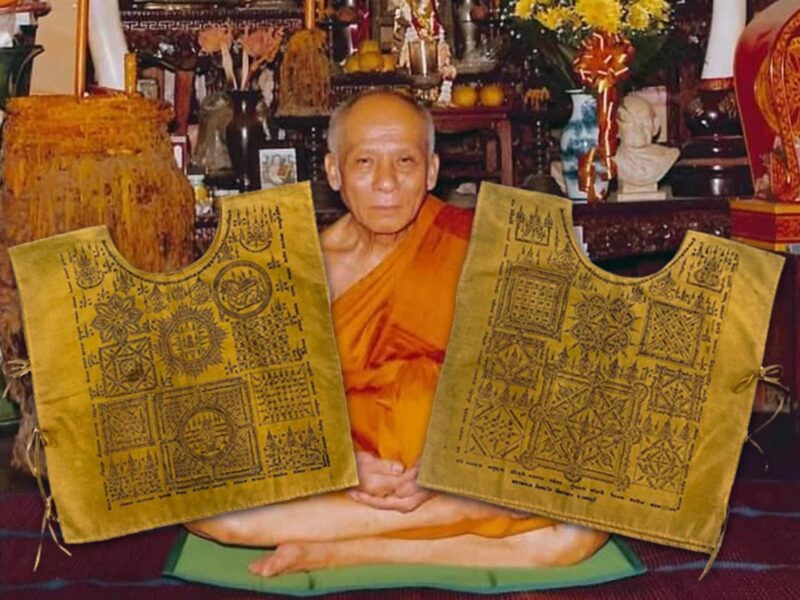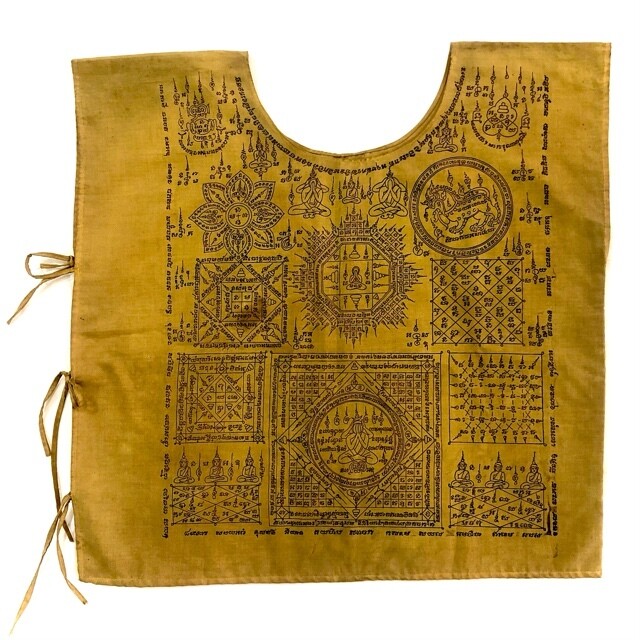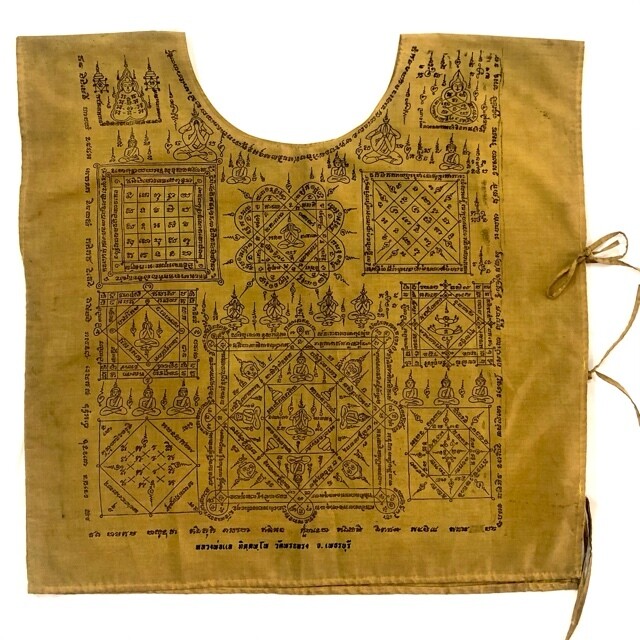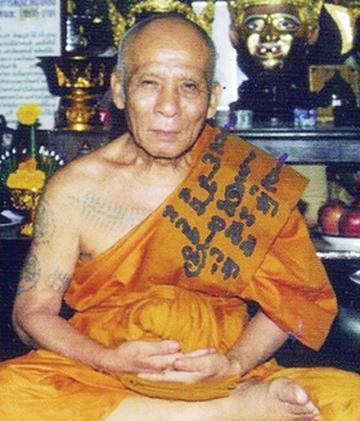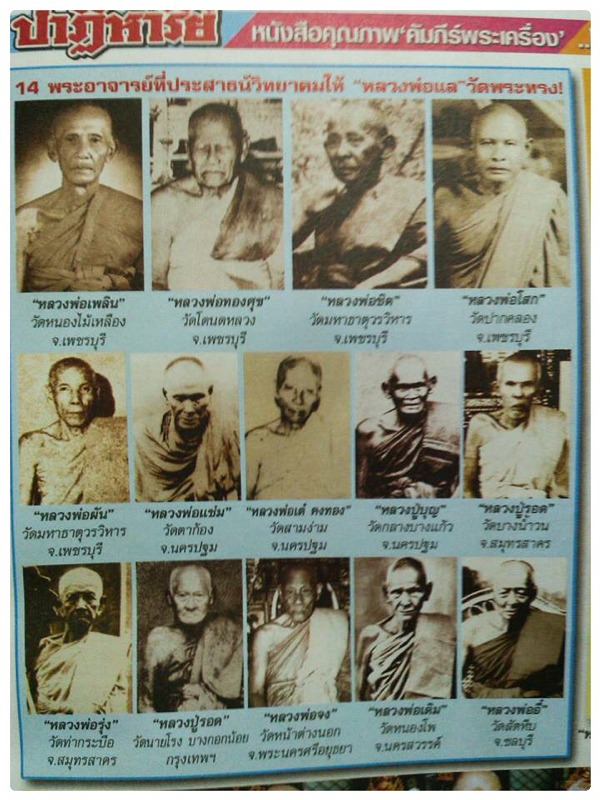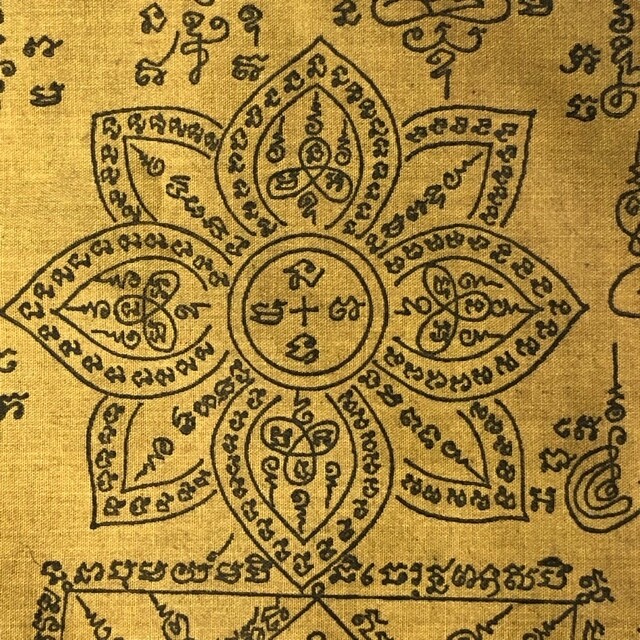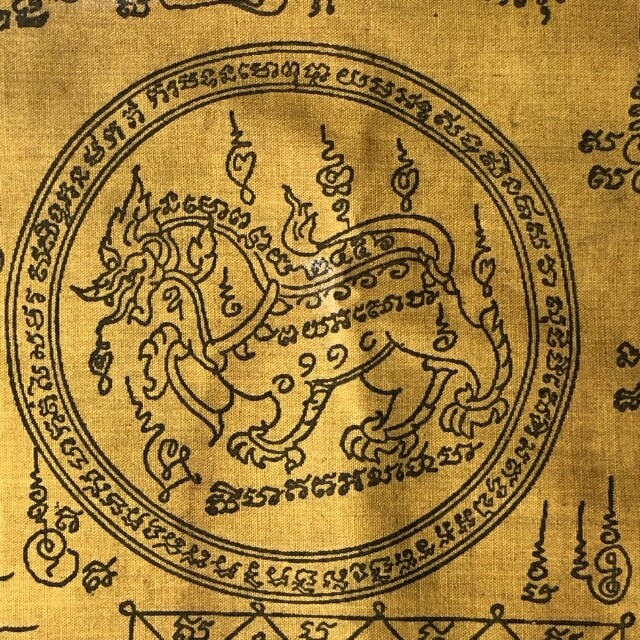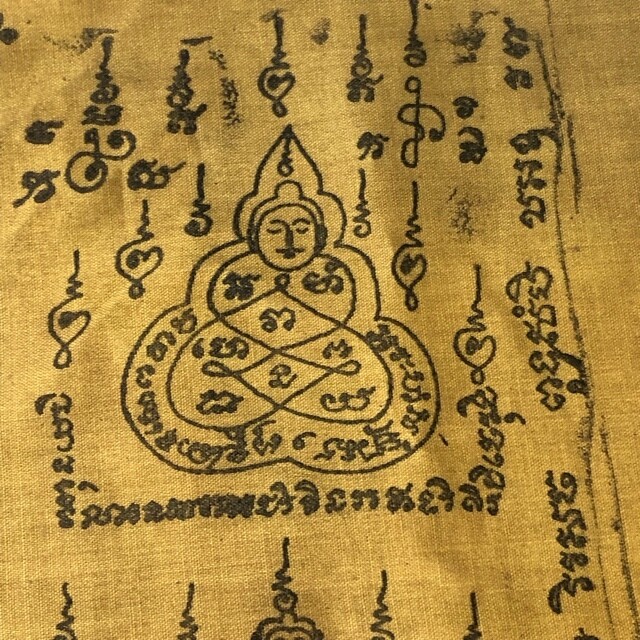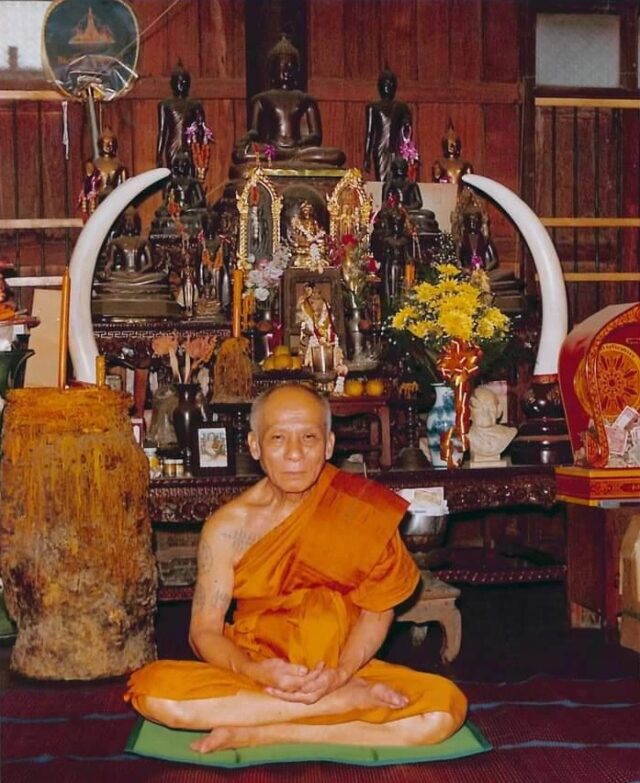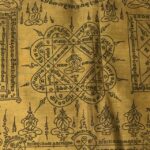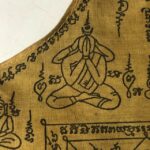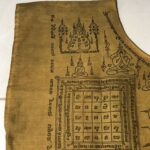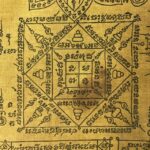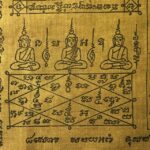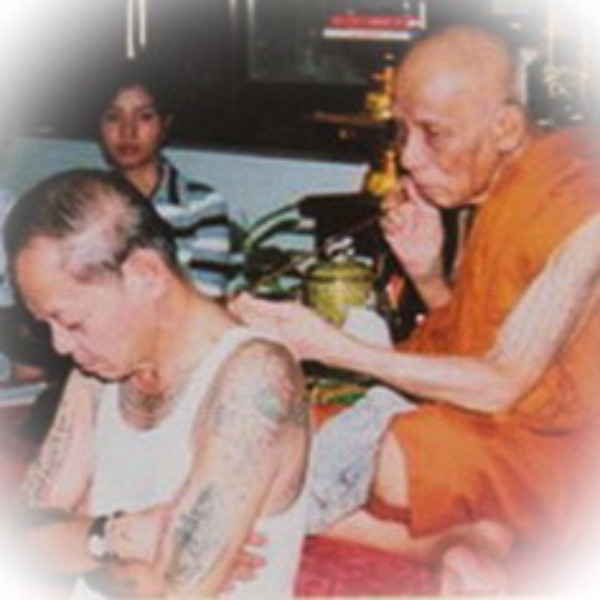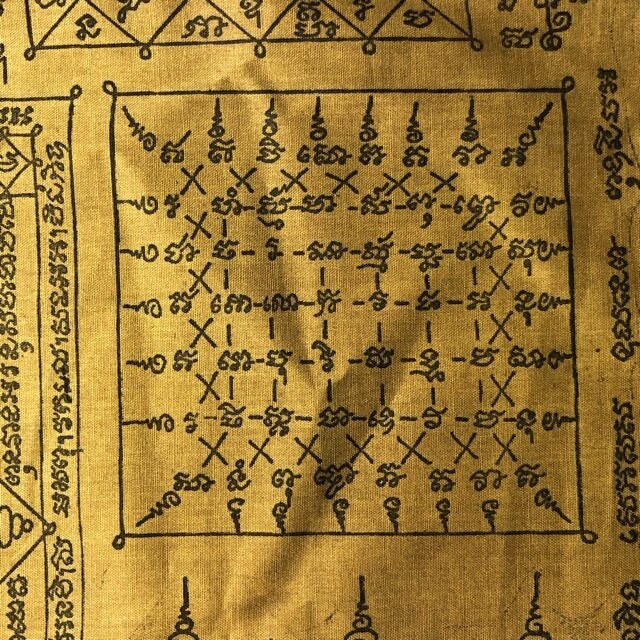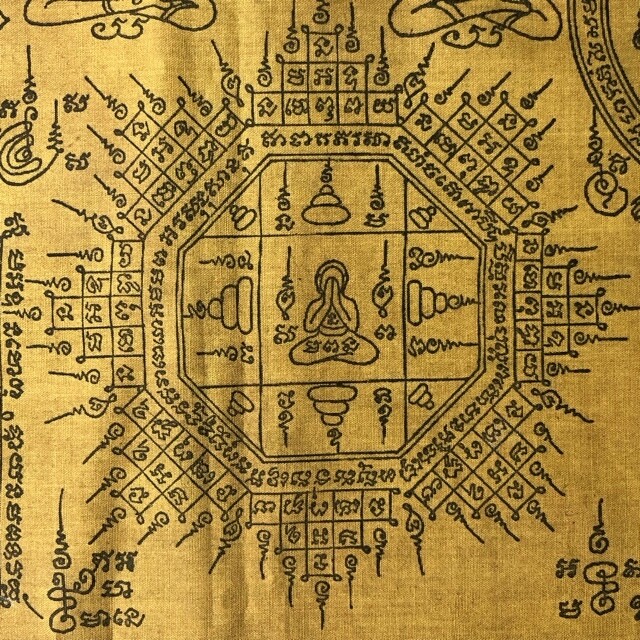An exceptionally rare and ancient Suea Yant Kong Grapan Chadtri Klaew Klaad Maha Ud Serm Yos, impeccably preserved, adorned with a plethora of Sacred Yant. This sacred yantra shirt, an undergarment symbolizing protection, invincibility, commanding power, mercy, and evasion of perilous circumstances, is a remarkable find. It hails from the illustrious master of Sak Yant Thai Temple Tattoos, Luang Por Lae of Wat Pra Song in Petchburi.
Luang Por Lae was a revered Thai Buddhist monk renowned for his expertise in creating Sak Yant tattoos, deeply significant in Thai culture and spirituality. His mastery was honed through guidance from various accomplished masters in the field, and his tattoos were sought after for their spiritual significance and protective qualities.
The Suea Yant is crafted from Ochre (Jivara Monk Robe Silken fine-weave Linen Cloth), boasting incredibly sharp and intricate details of the Sacred Yant. Each Yant features complex Buddhist and Occult Formulas inscribed in ancient Khom Agkhara script, enveloping and surrounding each Yantra spell. This amalgamation forms an adamantine spiritual barrier featuring Buddhas, Bodhisattvas, Herukas, Dakinis, Devas, Himapant Protective Deities, Ruesi, and the Hindu Trinity, providing protection and blessings in all aspects of life.
Luang Por Lae Tidtappo of Wat Pra Song in Petchburi was a direct disciple in Dhamma and Sorcery to two of the most esteemed Masters of bygone eras—the legendary Luang Por Tong Sukh of Wat Tanode Luang and Luang Por Plern of Wat Nong Mai Luang. Luang Por Lae was born on June 19, 2459 BE, in Tambon Rai Makham, Ban Lard, Petchburi Province. He entered the Buddhist Sangha at almost 20 years old on May 24, 2499 BE.
Luang Por Lae was a Thai Buddhist monk renowned for his expertise in creating Sak Yant tattoos. Sak Yant tattoos featured sacred designs, often representing Buddhist symbols, traditionally inked onto the skin. Luang Por Lae was well-known for his proficiency in this art form and had received training from respected teachers, especially in the field of high-level spiritual tattoos.
He had learned and honed his skills in Sak Yant from several accomplished Ajarns (masters), particularly those who specialized in enhancing spiritual insight through tattoos. Luang Por Lae had created various Sak Yant designs, which were typically intricate patterns with deep spiritual significance in the Buddhist tradition. These tattoos were considered to be a form of protection and carried spiritual power.
Luang Por Lae’s mastery in Sak Yant had earned him a prominent place in the realm of Thai Buddhism and culture. His work had been highly regarded for its artistic and spiritual value, and his tattoos were often sought after by those seeking spiritual guidance and protection.
Luang Por Lae studied Sorcery with a total of 14 different Masters; LP Plern (Wat Nong Mai Lueang), LP Tong Sukh (Wat Tanode Luang), LP Chit (Wat Maha Tat Petchburi), LP Soke (Wat Pak Klong), LP Pan, LP Te, LP Chaem, LP Bun, LP Rod (Wat Nai Roeng), LP Rod (Wat Bang Nam Won), LP Rung Wat Ta Graber, LP Jong (Wat Na Tang Nork), LP Derm (Wat Nong Po), and Luang Por Ee (Wat Sattaheeb).
Luang Por Chit of Wat Mahatat taught him the adept levels of Wicha Horasart (Astrology and Fortune Telling), and it is said that Luang Por Lae attained the 6th sense in this Wicha, able to foresee future events. Luang Por Soke of Wat Pak Klong in Ban Laem taught Luang Por Lae the Wicha Pra Khan (Scepter, Ritual Dagger, and Wand Magic). Luang Por Pan of Wat Mahatat Voravihanr taught Luang Por Lae the Wicha of Takrut Tone and Takrut Faed amulets.
The Great Luang Por Plern of Wat Nong Mai Luang, Famous for Wicha Hwaen Pirod, and Kong Grapan Magic passed on his magical secrets to Luang Por Lae. Luang Por Tong Sukh, Wat Tanode Luang, who taught him to perform Wicha Sak Yant Kroo, which was the most powerful Yant in his particular Magical Dtamra, namely the Yant Hua Jai Pra Ram (Heart of Rama Yantra), which controls the powers of all other Yant tattooed thereafter on the devotee, including the Ling Lom Vanora, Hanuman, & Gold and Silver Hongsa Swans.
He was taught the Wicha Sak Yant Maha Maekh from Luang Por Dtor and Kun Por Jantr of Wat Khao Wang in Petchburi, and after their passing, for a long time, Luang Por Lae remained the only Monk able to perform this Wicha.
In the year 2489 BE, an event happened that caused Luang Por Lae to receive a shock. He was staying at Wat Maha Tat when he received terrible news about his family home being broken into by marauders, who killed his mother and siblings (his father had already passed away beforehand). The only thing left in the home was a piece of gold weighing 100 grams, which the thieves had dropped as they fled the house. Luang Por Lae used this gold to pay for the funerals of his mother and siblings.
This tragic event led Luang Por Lae to embark on a journey of solitary forest wandering, traveling by foot across the land. His aim was to master potent Wicha, enabling him to help prevent such dreadful events in the future and to perform magical miracles for the protection of others, as his own family had suffered.
During his wanderings through the wild and undeveloped areas between Petchburi and as far as Nakorn Pathom province, Luang Por Lae met and practiced various forms of Wicha with numerous great Masters of that time. Notably, he learned the Wicha Kala ta Diaw Rahu Om Jantr (one-eyed coconut Pra Rahu Maha Ud Gunstopper spell) and the Wicha Serm Duang Karma Improver spell from Luang Por Chaem of Wat Ta Gong.
He furthered his travels, mastering Wicha Choo Chok with Luang Phu Rod of Wat Bang Nam Won as he passed by Tonburi. As he ventured into Ayuttaya Province, he learned the Wicha Takrut Puang and the Wicha of the Yant Hua Jai Pla Tapian Maha Lap from the Great Luang Por Jong of Wat Na Tang Nork. He continued northwards to Nakorn Sawan, mastering the Wicha Sastra Mitmor Ritual Knife making with the Legendary Luang Por Derm of Wat Nong Po.
Returning to Petchburi, Luang Por Lae studied the Wicha Palad Khik with his Kroo Ba Ajarn Luang Por Ee of Wat Sattaheeb. He subsequently used his acquired Wicha to assist the local devotees and later became the Abbot of Wat Pra Song.
Luang Por Lae passed away in the Year 2551 BE on March 10th, at the age of 92.
Wicha Sak Yant LP Lae
Luang Por Lae was famed for his Sak Yant tattoos, featuring his unique formula of Nine types of Hanuman/Vanora. However, it’s worth noting that after tattooing a ‘very important person,’ he ceased tattooing the 9th Hanuman and Hanuman number 10. He would only tattoo up to 8 of them on any single individual. His amulets are coveted collector’s items in a niche market and are often challenging to find. Devotees in Petchburi and surrounding provinces are known for their possessiveness and non-commercial nature regarding these amulets. As a result, only a few amulets from this master ever leave the locality and are primarily held within his circle of devotees.
Luang Por Lae holds a special place in the hearts of Sak Yant tattoo enthusiasts and those enamored with the diverse range of amulets he crafted during his lifetime, including Hanuman amulets, Ganesha, Taw Waes Suwan, and Por Gae Lersi amulets, all meticulously hand-carved from ivory. His collection boasts an array of attractive amulet designs, considered fine works of Buddhist art in their own right.
Additionally, his historical prominence is attributed to his tutelage in Sorcery and Dhamma under the guidance of 14 revered Guru Master Ajarns, who imparted their profound Wicha to him.
